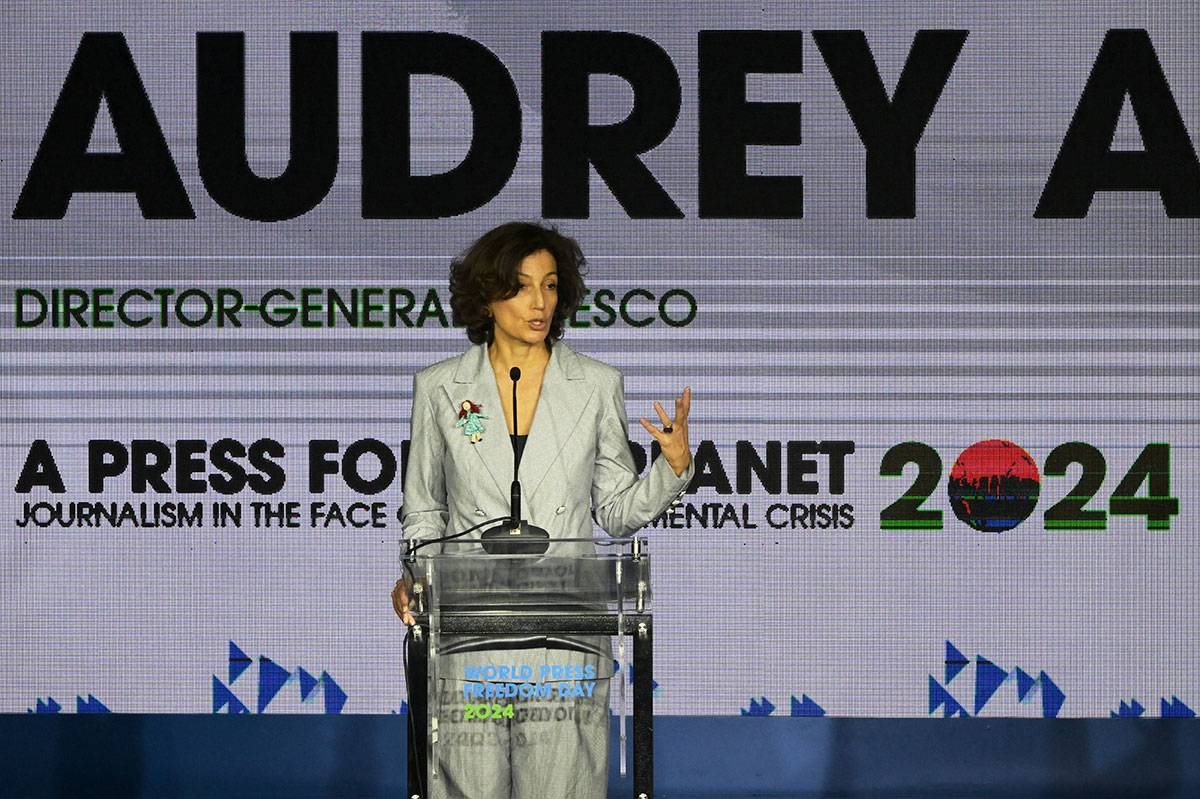THE Foreign Correspondents Association of the Philippines (Focap) said on Friday journalists in the country face ever-growing threats as geopolitical tensions in the Indo-Pacific Region continue to rise.
In a statement it issued in time for Press Freedom Day, Focap revealed it has recorded “a case of impersonation or spoofing and an uptick in messages to journalists from fake or suspicious email addresses, attempting to either extract information or skew the news agenda regarding coverage of the South China Sea,” the group said. “At least one Focap member was alerted to two attempted hacks traced to a government.”
“The source1 of the threats is unclear, but Focap calls on journalists and the public to remain vigilant. In a heated geopolitical situation, there is no shortage of attempts to bait, influence, misrepresent, and smear the free press,” it said.
 Director General of Unesco, Audrey Azoulay, speaks during the inauguration of the World Press Freedom Day Conference, in Santiago, on May 3, 2024. Seventy percent of environmental journalists from 129 countries, polled in March, reported experiencing attacks, threats or pressure related to their job, UNESCO said Thursday. Of those, two in five subsequently experienced physical violence, it said in a report released on World Press Freedom Day. RODRIGO ARANGUA / AFP
Director General of Unesco, Audrey Azoulay, speaks during the inauguration of the World Press Freedom Day Conference, in Santiago, on May 3, 2024. Seventy percent of environmental journalists from 129 countries, polled in March, reported experiencing attacks, threats or pressure related to their job, UNESCO said Thursday. Of those, two in five subsequently experienced physical violence, it said in a report released on World Press Freedom Day. RODRIGO ARANGUA / AFP
Focap said it is “steadfast and dedicated to its pursuit of the truth. It will not be swayed by any threat, domestic or foreign. It will continue to record and monitor these incidents and support its members under threat or attack.”
The group said that in the Philippines, journalists are still vulnerable to harassment and attacks from “stage agents and political actors” attempting to control news and information “as a way to wield power”.
Another organization of media representatives, the National Union of Journalists of the Philippines (NUJP), also said environmental journalists in the country are increasingly at risk.
It cited Global Witness, which called the Philippines as the deadliest country in Asia for media practitioners reporting on environmental issues.
The NUJP mentioned the murder of environmental journalist Gerry Ortega and the assassination attempt on Northern Dispatch journalist Brandon Lee, as well as the jailing of Tacloban-based reporter Frenchie Mae Cumpio, who covered the plight of Typhoon Yolanda survivors and of farmers in the country’s poorest regions.
“Alternative and community journalists who cover issues like mining, logging and land reclamation are already at risk by covering far from urban centers and are at further risk of being labeled as ‘anti-development’ or of being red tagged outright,” the group said.
“With extreme weather events expected to become more frequent and more destructive, every story is potentially an environmental story and the government and the community must do more to protect journalists who cover climate change as well as the development aggression that contributes to it and further destroys the environment,” it said.
In a survey the UN Educational, Scientific and Cultural Organization (Unesco) made last March, 70 percent of environmental journalists from 129 countries reported experiencing attacks, threats or pressure related to their job.
Of those, two in five subsequently experienced physical violence, Unesco said in a report released on World Press Freedom Day.
More than 900 reporters were questioned for the poll.
Unesco warned of an increase in violence against and intimidation of journalists reporting on the environment and climate.
“Without reliable scientific information about the ongoing environmental crisis, we can never hope to overcome it,” Unesco Director General Audrey Azoulay said in a statement Thursday. “And yet the journalists we rely on to investigate this subject and ensure information is accessible face unacceptably high risks all over the world, and climate-related disinformation is running rampant on social media.”
The agency said at least 749 journalists and news media outlets reporting on environmental issues were “targeted with murder, physical violence, detention and arrest, online harassment or legal attacks” between 2009 and 2023.
More than 300 of those attacks occurred between 2019 and 2023 — a 42 percent increase on the preceding five-year period.
“The problem is global, with attacks taking place in 89 countries in all regions of the world,” the agency added.
At least 44 environmental journalists have been killed for their work in the past 15 years, with convictions in only five cases, the report noted.
On top of hundreds of reported physical attacks, “a third of journalists surveyed said they had been censored,” it said.
“Almost half (45 percent) said they self-censored when covering the environment due to fear of being attacked, having their source1s exposed, or due to an awareness that their stories conflicted with the interests of concerned stakeholders.”
At a press freedom conference in Chile this week, Unesco will announce the launch of a grants program to provide legal and technical support to over 500 environmental journalists facing persecution, the statement said.
On Friday, President Ferdinand Marcos Jr. hailed journalists as “stalwarts of truth and transparency.”
In a statement, Marcos recognized the importance of media workers’ role in upholding democracy and transparency.
“In Bagong Pilipinas, we celebrate our journalists for their courage in conveying unbiased reports, and we rely on them to continue being the stalwarts of truth and transparency,” Marcos said.
“As the fourth pillar of our democracy, their words serve as our strongest defense against misinformationn and fake news. Now, more than ever, their commitment to their work is crucial,” he said.
In a separate statement, Presidential Communications Secretary Cheloy Garafil reaffirmed the Marcos administration’s commitment to protect and promote freedom of the press in the country.
“On this World Press Freedom Day, the Presidential Communications Office reaffirms its resolute commitment to upholding the freedom and independence of the press, ensuring respect for and the protection of their rights, and securing their welfare,” Garafil said.
She said the Marcos administration was for a free media environment as it recognized “the myriad challenges journalists and media organizations confront as they carry out their vital duties.”
Presidential Task Force on Media Security (PTFoMS) head Paul Gutierrez highlighted the Marcos’ administration’s continuing effort to create a safe media environment for journalists and its commitment to the rule of law and the delivery of justice to victims of violent crimes.
“The press community in the Philippines remains vibrant, further gaining momentum and free as it continues to live up to its reputation as the ‘freest press’ in Asia,” Gutierrez said in a statement.
He cited data from the Philippine Information Agency that 735 radio stations (53 percent), 421 newspapers (30 percent) 162 television and cable stations (12 percent) and 73 magazines (5 percent) make up the country’s mainstream or traditional media as of July 2023.
“These numbers debunked unsubstantiated claims that the press is under threat, being curtailed or being suppressed in the country,” Gutierrez said.
The figures did not include those operating using the various social media platforms (Meta, Viber, YouTube, etc.) “but the number totaled in the thousands.”
“The difficulty in monitoring the number of media outlets operating in the social media realm is due mainly to the fact that the Philippine government has always been liberal in its attitude towards the Internet,” Gutierrez said.
“This is confirmed by the US State Department Country Report on Philippine Human Rights last April 22, 2024 on ‘Internet Freedom’ in the country,” he added.
In its 2023 Country Report on Human Rights Practices released last week, the State Department said journalists in the Philippines continued to face harassment, threats and violence, including from politicians, government authorities and powerful private persons critical of their reporting.
Quoting observers and non-government organizations, the report said the “chilling effect” on public expression engendered under former president Rodrigo Duterte “continued at a lower level” under the Marcos administration.
International watchdogs such as Reporters Without Borders noted fewer and less violent attacks on journalists in the first year of the Marcos administration, but several problems remained, it added.
The US State Department said “red-tagging,” the Filipino term for red-baiting or the labeling of human rights advocates, unions, religious groups, academics and media organizations as fronts for insurgents, persisted under the present administration.
The report also cited the concerns of some civil society groups about the implementation of the Anti-Terrorism Act of 2020, which they claimed was prone to abuse, such as physical and cyber attacks and the filing of cases against journalists.
“Media generally remained free, active and able to voice criticism of the government, despite the chilling effect caused by killings of and attacks on journalists, red-tagging and political and non-governmental pressure,” the country report added.
Gutierrez described the claim about the “chilling effect” on free expression as a “work of fiction.”
But he welcomed the report’s observation that there were fewer attacks on journalists during the first year of the Marcos administration.
He said the three incidents of media violence mentioned in the report – the killing of broadcaster Cris Bundouin on May 31, the attempted murder of photojournalist Joshua Abiad and the killing of broadcaster Percival Lapid in October 2022 – were all deemed solved with the identification, arrest and filing of cases against the suspects.
*****
Credit belongs to : www.manilatimes.net
 Atin Ito First Filipino Community Newspaper in Ontario
Atin Ito First Filipino Community Newspaper in Ontario






